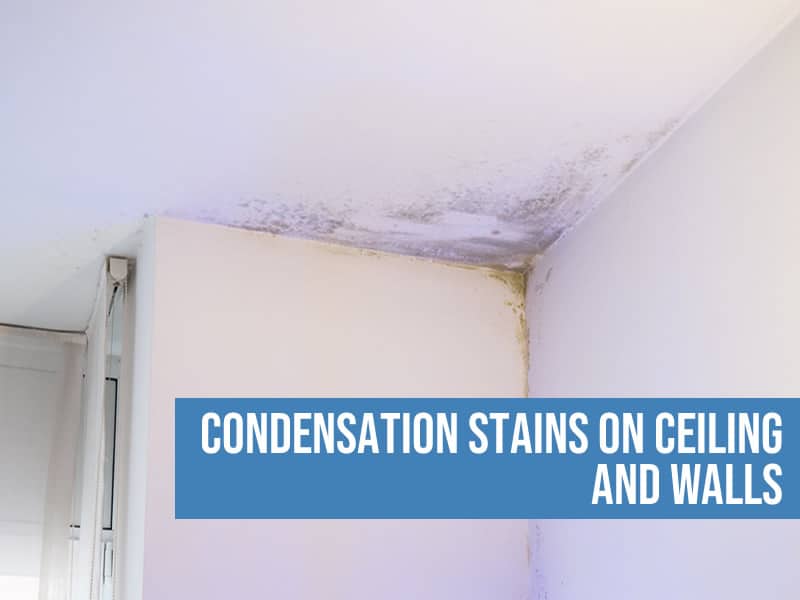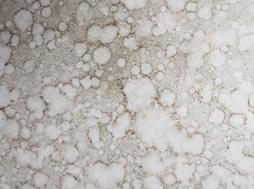 Do you notice odd stains on your ceiling and walls? There is a high chance it is caused due to condensation or moisture. Condensation stains on ceiling and walls are quite common and are faced by many homeowners.
Do you notice odd stains on your ceiling and walls? There is a high chance it is caused due to condensation or moisture. Condensation stains on ceiling and walls are quite common and are faced by many homeowners.
It may be caused due to excess moisture leading to the formation of mildew and mold. But a small stain can turn into a big problem when ignored for too long. If the stains are caused by mold, it can be potentially risky to your health. In this case, you need to hire a contractor to repair the affected areas.
Condensation on your ceiling takes place when the attic space above is poorly insulated and ventilated. The heat gets trapped in the attic and warms the ceiling. When cool air from your living space goes up due to humidity, it touches the warm surface of the ceiling and forms condensation.
This can lead to condensation stains on ceiling and walls. However, this can be prevented by correcting the poor insulation and ventilation issues in your attic.
If you can relate to it and need help, you are in the right place. In this post, I will tell you everything you need to know about stains caused due to condensation on ceilings and walls.
Condensation Stains On Ceiling
Condensation stains on ceiling are more common than you think. If you thought, you are the only one having them in your house, you are wrong.
They often take place due to poor insulation and ventilation up your attic. When the heat gets trapped inside, it warms up the entire attic space. Later, when the cool air rises from the living space to the attic and comes in contact with the warm surfaces, it forms condensation ceiling stains.
Another reason that could lead to this problem is the formation of mold and mildew due to excess moisture levels. If you notice mold growth, it can be harmful to your health. In this case, you should call a mold remediation service to get rid of it and treat the area.
No matter, the cause, it looks ugly on your ceilings and walls. As a homeowner, you should take immediate steps to solve the issue. But before that, you need to get to the root of the problem, so that you can prevent it from happening again. In the upcoming sections, I will discuss how to solve this problem.
Condensation Stains On Walls
Condensation stains on walls take place when a warm surface comes in contact with cool air. It forms tiny droplets of water that leave the stains behind. This means they’re actually very similar to water stains.
If you notice them, you should follow this steps by step guide below to clean them.
- Prepare a mix of water and bleach in a 3:1 ratio. In case, you don’t have bleach, you can use any bathroom cleaner that contains bleach.
- This mixture should be effective in cleaning stains and also remove any mildew or mold
- Now make sure that the spot is dry. Let it be like that for a while, so that it can dehydrate. You can also use a dehumidifier if you want.
- Sometimes drying and cleaning are not enough. You may have to replace certain materials from the area.
- Once the area is dry, apply a fresh coat of stain-blocking primer.
- Let the primer dry for 2 hours and after that, you can complete the paint job to make the area look new.
Condensation On Bathroom Ceiling
 Bathrooms often have high levels of moisture and humidity, which are released into the air by taking a shower. When the moisture mixes with air as water vapor and comes in contact with a cold surface, it forms tiny droplets of water o windows and mirrors. If the water vapor is hot, the air will hold more moisture and thus, more will be deposited on cold surfaces.
Bathrooms often have high levels of moisture and humidity, which are released into the air by taking a shower. When the moisture mixes with air as water vapor and comes in contact with a cold surface, it forms tiny droplets of water o windows and mirrors. If the water vapor is hot, the air will hold more moisture and thus, more will be deposited on cold surfaces.
Condensation on bathroom ceiling becomes a bigger issue, whenever you take a hot shower. This can lead to mold and mildew formation in your bathroom. This will not only ruin the surfaces, but it is also hazardous to your health, especially for people who are allergic.
But if you follow the right tips, you can prevent condensation before it even happens. You should always remember that every bathroom is different, which means you will have to figure out what will work best for your specific situation.
Here are some tips you should follow:
- Install a dehumidifier in the bathroom
- Install an extractor fan
- Use a demisable mirror
- Warm up the bathroom walls and ceiling
- Properly ventilate your bathroom
- Keep wet surfaces dry
- Apply anti-condensation paint
By following these tips, you can clean condensation stains on bathroom ceiling.
Condensation Stains On Drywall
Condensation stains on drywall mainly occur during the winter months. Almost all indoor air contains some amount of moisture. Condensation forms when such air comes in contact with colder surfaces. Water existing in vapor form turns liquid when it is cooled to the right temperature.
However, the temperature at which this occurs may vary based on the amount of moisture in the air, the temperature of the air, and the cold object.
At cold spots, condensation forms on walls, ceilings, doors, and windows. Some of the main causes include:
- A disconnected bathroom dryer tube pumps warm air into the attic that condenses on touching the cold attic surfaces. This can result in a water pool in the attic drywall.
- When indoor humidity levels are not compatible with outdoor temperatures, it creates stains on cold surfaces.
- Condensation can also form inside exhaust fan tubes and runs back down to the fan and leaving a stain on the surrounding drywall.
Condensation Dripping From Ceiling Vent
Condensation dripping from ceiling vent can have a bad impact on the ceiling material surrounding the vent. Not just that, but it can also affect the furnishings and carpeting sitting under the vent.
To fix this unpleasant problem, you should follow these steps:
- Set up a ladder below the ceiling vent.
- Loosen two screws and lower the ceiling vent when both screws are removed.
- Take a tube of silicone caulk and apply it to all four corners of the grill box using a paintbrush. Make sure you cover all the corners. Once you are done with the application process, let it dry for at least 24 hours.
- Push the ceiling vent into the opening and align the holes of the vent with the holes in the ceiling material.
- Now crawl into the attic and locate the flex duct. Look for any gaps in the insulation.
- Measure the size of any insulation gaps using a measurement tape. After that lay a piece of thick foil-backed insulation across multiple ceiling rafters.
- Cut a piece of insulation to the required size and set it in the gap. Cover the area with metal foil tape to keep the insulation in place.
- Repeat the process until no gaps are left.
- You should caulk all remaining ceiling vents with condensation issues.
Well, that’s how you can fix condensation dripping from ceiling vent.
Condensation On Ceiling In Summer
As already discussed above, one of the major causes of condensation on ceiling in summer is an attic with poor insulation and ventilation. In an attic like this, when cold air rises and hits the warm attic, condensation forms. This mainly happens during the wintertime. But the reverse may happen during the summer months.
In order to solve this issue, you need to improve the attic’s air sealing and insulation. This will prevent attic air from reaching your ceiling. You can start by checking the insulation level in your attic. If the floor joints are visible, it means you need more insulation.
How to get rid of condensation stains on ceiling?
There are multiple ways to effectively prevent and remove this problem. In this section, I will tell you how to get rid of condensation stains on ceiling and walls with just a few easy tips.
- Check your vents
Make sure that your vents exit your home. After all, you wouldn’t want humid air to get trapped inside your house during the winter.
- Avoid using humidifiers
Winters are dry and uncomfortable. It can even cause respiratory discomfort to some. But using a humidifier could lead to attic condensation problems. If you already have an attic condensation issue, it is better not to use a humidifier.
- Check your attic insulation
Make sure that your attic has enough insulation so that it can prevent warm, humid air from reaching there. You can call an insulation professional to get the insulation done.
Those who want to know how to remove condensation stains from ceiling, should refer to the previous sections where I have already explained the steps.
Q&A
How do you know if you have a leak or condensation?
A condensation stain looks different than a leak. It appears blotchy, where the water droplets have formed on the surface.
Why is the condensation so bad in my house?
Condensation happens when you have a poorly insulated and ventilated attic. If you have condensation, you should check your attic to fix the issue.
Does opening windows reduce condensation?
Opening windows will let the humid air escape and therefore, will prevent condensation from taking place. So, if it’s not too cold out and you’re suffering from condensation, you should open a window.
Can condensation cause a leak?
Condensation forms when warm air hits a colder surface and releases excess moisture on the surface. Once it melts, the moisture can mimic a leak and cause a stain on your ceiling and walls.
Why does my toilet get condensation?
Your toilet is a natural dehumidifier. It forms moisture on the surface of the tank because the tank water is colder than the surrounding temperature of the air. This difference in temperature causes the air to release water and that leads to condensation.
Conclusion
Condensation stains on ceiling and walls are formed mainly due to an attic with poor insulation and ventilation. If you notice them inside your house, you should fix the insulation of your attic and paint the affected area to remove the stains.
